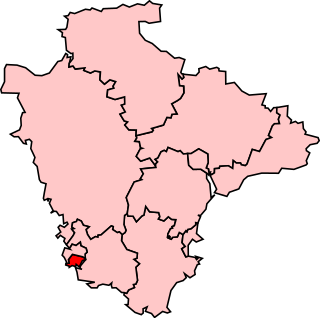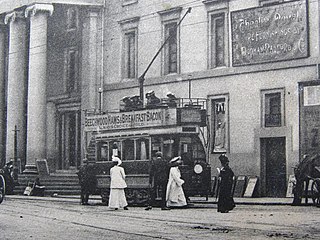
Mutley Plain is a street in Plymouth, Devon, England. Although Mutley Plain is the main street of the dense suburb called Mutley, the term is often applied to the whole area. The road is now a busy dual-carriageway, the B3250, with eight sets of traffic lights/pelican crossings. It was built as a smart tree-lined avenue in late Victorian times and improved over the next half century as a local shopping place for its neighbourhood and the affluent area to the north.

Eggbuckland is a suburb of the city of Plymouth, in the ceremonial county of Devon, England. Before the Second World War Eggbuckland was a small village a few miles north of Plymouth. During the reconstruction of Plymouth many new suburbs were built and soon a new estate was built within one mile to the south east of Eggbuckland. During the 1970s the areas in between and surrounding the old village were all developed and the whole area is now referred to by the name Eggbuckland. The development of the A38 just south of Eggbuckland in the 1980s led to the area becoming very popular with commuters.

Laira – previously recorded as Lare (1591), Lary poynte (1638), the Leerie (1643), and the Lairy (1802) – was originally the name given to that part of the estuary of the River Plym from the Cattewater up to Marsh Mills in Plymouth, Devon, England. The name may derive from a Brythonic word corresponding to the Welsh llaeru, meaning 'to ebb'.

Plymouth, Sutton was, from 1918 until 2010, a borough constituency represented in the House of Commons of the Parliament of the United Kingdom. It elected one Member of Parliament (MP) by the first past the post system of election.

Plymouth Sutton and Devonport is a constituency created in 2010, and represented in the House of Commons of the UK Parliament since 2017 by Luke Pollard of the Labour and Co-operative Party.

Plympton railway station was a former railway station located at Plympton in Devon on the South Devon Main Line between Exeter and Plymouth. Plympton was a town in its own right when the railway was constructed but is today an eastern suburb of the city of Plymouth.

Hawthorne is a suburb of the City of Brisbane, Queensland, Australia. In the 2021 census, Hawthorne had a population of 5,090 people.

Woolwell is a suburb on the north-east fringe of the city of Plymouth, England, located just outside the city's boundaries in the district of the South Hams. It is situated along the A386, close to the boundary of Dartmoor National Park, with good views of the surrounding landscape. Housing development began in Woolwell in 1981 and there is now a population of slightly over 3000. For an area of its size, it has a large number of facilities, including its own primary school, a medical centre and several shops.

There are eleven disused railway stations on the Exeter to Plymouth line between Exeter St Davids and Plymouth Millbay in Devon, England. At eight of these there are visible remains.

The Exeter to Plymouth railway of the London and South Western Railway (LSWR) was the westernmost part of a route competing with that of the Great Western Railway (GWR) and its 'associated companies' from London and Exeter to Plymouth in Devon, England. Whereas the GWR route from Exeter followed the coast to Newton Abbot and then went around the southern edge of Dartmoor, the LSWR route followed the northern and western margins of Dartmoor, passing through the towns of Crediton, Okehampton, and Tavistock.
Hartley is a suburb of Plymouth in the county of Devon, England.

Compton or Compton Gifford is a suburb of Plymouth, in the ceremonial county of Devon, England.
Efford is an historic manor formerly in the parish of Eggbuckland, Devon, England. Today it has been absorbed by the city of Plymouth to become a large, mostly post-World War II, eastern suburb of the city. It stands on high ground approximately 300 feet above the Laira estuary of the River Plym and provides views over long distances: to the north across Dartmoor, to the east and south-east across the South Hams. It consists predominantly of local authority and housing association properties. Before this land was built upon it was known as 'The Wilds of Efford', and was largely unspoilt countryside and marsh land. That a deer park may have been attached to the manor is suggested by the survival of the street name "Deer Park Drive".

Plymouth Friary railway station was the London and South Western Railway (LSWR) terminus in Plymouth, Devon, England.

Hyde Park Junior School (HPJS), founded in 1904, is a coeducational junior school located on Hyde Park Road, close to Mutley Plain in Plymouth, Devon, England. Catering for around 360 boys and girls between the ages of 7 and 11, it is housed in the same building as its partner school, Hyde Park Infants. The school's catchment area extends across part of the suburbs of Plymouth including Mutley and Mannamead.

Drake is an election ward within Plymouth, Devon, England. One of the main roads from the city to Tavistock and Dartmoor runs through the ward. In the past it played an important role in the supply of water to Plymouth, and it was the location of both a fatal bomb explosion and a large unexploded bomb during the Plymouth Blitz. The University of Plymouth has its main campus in this ward and the large student population has led to part of it being designated as one of the four areas subject to Designated Public Places Orders in the city. It is also the location of the city's main railway station, museum and public library.

The tramways in Plymouth were originally constructed as four independent networks operated by three different companies to serve the adjacent towns of Plymouth, Stonehouse and Devonport in Devon, England. The merger of the 'Three Towns' into the new borough of Plymouth in 1914 was the catalyst for the three companies to join up under the auspices of the new Plymouth Corporation. The network was closed in 1945, partly as a result of bomb damage during World War II.















